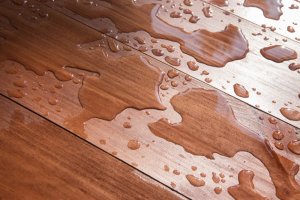What Happens When Wood Floors Get Wet? - Escarosa

If you have wood floors, you know firsthand how beautiful and durable they are. Wood, like any flooring, isn’t indestructible, though. Eventually, it starts to show signs of wear – especially when it encounters moisture. In this post, we’ll discuss what you need to know about how to save your wood floors if they get wet. We’ll also break down when to contact a professional to clean the floors for you.
What Water Does to Wood Floors
Wood is a porous material. This means that, over time, exposure to water will permeate the wood’s membranes, causing it to rot, soften, and fall apart.
Additionally, water compromises the structure of wood, leading to mold growth and expensive restoration efforts. While a splash from a spilled drink won’t ruin your wood floors, excessive moisture (from a burst pipe, flooding, OR using too much water to clean your floors) may.
How to Clean up Moisture on Your Floors
After water meets your wood floors, it’s critical to act quickly. Here are a few tips for cleaning up the mess and saving your floors:
1. Wipe up the spill
Even a small spill can cause staining if you leave it to sit. With this in mind, wipe up the spill as quickly as possible. Use towels and a dry rag mop to sop up the standing water.
2. Remove soaked objects from the floor
Once you’ve cleaned up the spill, remove water-soaked items (such as carpeting and wet furnishings) from the floor. If left in place, these items will continue to drive moisture into the wood. In the worst-case scenario, they can also lead to mildew and mold growth in as little as 24 hours after the initial water damage.
3. Clean the floor
Once you’ve removed all standing water, you’ll need to get rid of debris and dirt in the pores of the floor, which can further damage your now-vulnerable floor. To do this, use a disinfectant cleaner and a scrub brush with gentle bristles. Finally, apply a wood floor cleaner to remove traces of disinfectant and replace the wood’s conditioning agents.
As you clean the floor, be mindful of how much water you use. You don’t want to make things worse by using too much water, which is an easy mistake to make. For best results, hire our team to clean your floors for you. We’ll remove all traces of dirt and help rehydrate and seal your floors to prevent moisture damage.
4. Look for signs of mold
Once your floors are dry and clean, inspect them for signs of mold. Not only will mold ruin your floors, but it can cause health complications. When the flooring looks dry, check it for signs of mold. Most of the time, mold spores look like black, grey, or green speckles in wood.
Should you call a Professional?
If the water damage to your floors was extensive, you might need to call a professional restoration company. This team of experts will clean and repair the floors for you while also inspecting for and removing mold.
Here at Escarosa Cleaning and Restoration, our team specializes in water damage cleanup and repair as well as wood floor cleaning. Regardless of whether your leak was small or large, our team will clean up standing water, repair the damage, and help restore your floors to their former glory. Contact us today to learn more.












